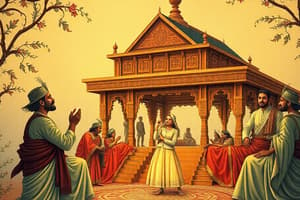Podcast
Questions and Answers
What was the primary motivation for Rammohan Roy's social and religious reforms?
What was the primary motivation for Rammohan Roy's social and religious reforms?
- To promote the study of Sanskrit, Arabic, Persian, and English
- To oppose meaningless religious ceremonies and pernicious social customs (correct)
- To introduce Western ideas and Christianity into Indian society
- To preserve traditional Hindu practices and customs
Which of the following languages was Rammohan Roy not proficient in?
Which of the following languages was Rammohan Roy not proficient in?
- Hindi (correct)
- Arabic
- Sanskrit
- Persian
What was Rammohan Roy's approach to social and religious reforms?
What was Rammohan Roy's approach to social and religious reforms?
- He was influenced by Western ideas and Christianity, and sought to introduce them into Indian society
- He wanted to preserve continuity with the past while opposing meaningless rituals and pernicious social customs (correct)
- He focused solely on promoting the study of Sanskrit, Arabic, Persian, and English
- He sought to completely abandon traditional Hindu practices and customs
Which of the following social practices did Rammohan Roy oppose?
Which of the following social practices did Rammohan Roy oppose?
What was the primary focus of Rammohan Roy's religious reforms?
What was the primary focus of Rammohan Roy's religious reforms?
How did Rammohan Roy's approach to social and religious reforms differ from that of other reformers of his time?
How did Rammohan Roy's approach to social and religious reforms differ from that of other reformers of his time?
What was Rammohan Roy's stance on the prevailing social customs of sati, child marriage, and polygamy?
What was Rammohan Roy's stance on the prevailing social customs of sati, child marriage, and polygamy?
What was Rammohan Roy's stance on the rights of widows to remarry?
What was Rammohan Roy's stance on the rights of widows to remarry?
What was Rammohan Roy's stance on the subjugation of women and the idea that women were inferior to men?
What was Rammohan Roy's stance on the subjugation of women and the idea that women were inferior to men?
What was Rammohan Roy's stance on education for women?
What was Rammohan Roy's stance on education for women?
What were the key features of the Brahmo Samaj founded by Rammohan Roy?
What were the key features of the Brahmo Samaj founded by Rammohan Roy?
What was the impact of the Brahmo Samaj on the culture of modern Bengal and its middle class?
What was the impact of the Brahmo Samaj on the culture of modern Bengal and its middle class?
Flashcards are hidden until you start studying
Study Notes
Raja Rammohan Roy and Brahmo Samaj
-
Rammohan Roy (1772-1833) was a scholar and reformer influenced by Western ideas, proficient in multiple languages, including Sanskrit, Arabic, Persian, English, and Bengali.
-
He opposed meaningless religious ceremonies and social customs, aiming to preserve continuity with the past while promoting a monotheistic and anti-idolatry outlook.
-
Roy argued that ancient Hindu texts, like the Upanishads, preached monotheism or the worship of one God.
-
He campaigned against social evils like sati, child marriage, and polygamy, petitioning the government to legislate against them.
-
Roy advocated for widows' rights to remarry and the abolition of polygamy, appealing to reason, humanity, and compassion.
-
His efforts contributed to the 1829 legislation abolishing sati, under Governor-General William Bentinck.
-
Roy supported education for women and the introduction of the English language and Western sciences in Indian schools and colleges.
-
He founded the Brahmo Samaj in 1828, establishing a temple in Calcutta without idols, where all religions were respected.
-
The Brahmo Samaj prohibited idol-worship, condemned meaningless religious rites, and ceremonies, but its appeal remained limited to intellectuals and enlightened Bengalis.
Maharishi Debendranath Tagore
-
After Rammohan Roy's death in 1833, Maharishi Debendranath Tagore (1817-1905), father of poet Rabindranath Tagore, continued the work.
-
Tagore formulated four articles of faith for the Brahmo Samaj:
-
The Supreme Being created the Universe and is the only God of Truth, Infinite Wisdom, Goodness, and Power.
-
Our salvation depends on believing in Him and His worship in this world and the next.
-
Belief consists in loving Him and doing His will.
Studying That Suits You
Use AI to generate personalized quizzes and flashcards to suit your learning preferences.




